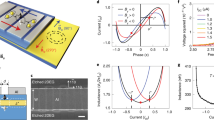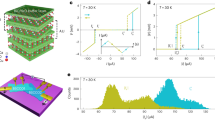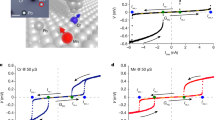Abstract
The recent discovery of the intrinsic supercurrent diode effect, and its prompt observation in a rich variety of systems, has shown that non-reciprocal supercurrents naturally emerge when both space-inversion and time-inversion symmetries are broken. In Josephson junctions, non-reciprocal supercurrent can be conveniently described in terms of spin-split Andreev states. Here we demonstrate a sign reversal of the Josephson inductance magnetochiral anisotropy, a manifestation of the supercurrent diode effect. The asymmetry of the Josephson inductance as a function of the supercurrent allows us to probe the current–phase relation near equilibrium, and to probe jumps in the junction ground state. Using a minimal theoretical model, we can then link the sign reversal of the inductance magnetochiral anisotropy to the so-called 0−π-like transition, a predicted but still elusive feature of multichannel junctions. Our results demonstrate the potential of inductance measurements as sensitive probes of the fundamental properties of unconventional Josephson junctions.
This is a preview of subscription content, access via your institution
Access options
Access Nature and 54 other Nature Portfolio journals
Get Nature+, our best-value online-access subscription
$29.99 / 30 days
cancel any time
Subscribe to this journal
Receive 12 print issues and online access
$259.00 per year
only $21.58 per issue
Buy this article
- Purchase on Springer Link
- Instant access to full article PDF
Prices may be subject to local taxes which are calculated during checkout



Similar content being viewed by others
Data availability
The data that support the findings of this study are available at the online depository EPUB of the University of Regensburg, with the identifier https://doi.org/10.5283/epub.53466. Source data are provided with this paper.
Code availability
The computer codes that support the theoretical results, the plots within this paper and other findings of this study are available from the corresponding author upon reasonable request.
References
Ando, F. et al. Observation of superconducting diode effect. Nature 584, 373–376 (2020).
Baumgartner, C. et al. Supercurrent rectification and magnetochiral effects in symmetric Josephson junctions. Nat. Nanotechnol. 17, 39–44 (2022).
Baumgartner, C. et al. Effect of Rashba and Dresselhaus spin–orbit coupling on supercurrent rectification and magnetochiral anisotropy of ballistic Josephson junctions. J. Phys. Condens. Matter 34, 154005 (2022).
Wu, H. et al. The field-free Josephson diode in a van der Waals heterostructure. Nature 604, 653–656 (2022).
Jeon, K.-R. et al. Zero-field polarity-reversible Josephson supercurrent diodes enabled by a proximity-magnetized Pt barrier. Nat. Mater. 21, 1008–1013 (2022).
Pal, B. et al. Josephson diode effect from Cooper pair momentum in a topological semimetal. Nat. Phys. https://doi.org/10.1038/s41567-022-01699-5 (2022).
Bauriedl, L. et al. Supercurrent diode effect and magnetochiral anisotropy in few-layer NbSe2. Nat. Commun. 13, 4266 (2022).
Turini, B. et al. Josephson diode effect in high-mobility InSb nanoflags. Nano Lett. 22, 8502–8508 (2022).
Gupta, M. et al. Gate-tunable superconducting diode effect in a three-terminal Josephson device. Nat. Commun. 14, 3078 (2023).
Zhang, B. et al. Evidence of φ0-Josephson junction from skewed diffraction patterns in Sn-InSb nanowires. Preprint at arXiv https://doi.org/10.48550/arXiv.2212.00199 (2022).
Mazur, G. P. et al. The gate-tunable Josephson diode. Preprint at arXiv https://doi.org/10.48550/arXiv.2211.14283 (2022).
Diez-Merida, J. et al. Symmetry-broken Josephson junctions and superconducting diodes in magic-angle twisted bilayer graphene. Nat. Commun. 14, 2396 (2023).
Lin, J.-X. et al. Zero-field superconducting diode effect in small-twist-angle trilayer graphene. Nat. Phys. 18, 1221–1227 (2022).
Scammell, H. D., Li, J. I. A. & Scheurer, M. S. Theory of zero-field superconducting diode effect in twisted trilayer graphene. 2D Mater. 9, 025027 (2022).
Lu, B., Ikegaya, S., Burset, P., Tanaka, Y. & Nagaosa, N. Josephson diode effect on the surface of topological insulators. Preprint at arXiv https://doi.org/10.48550/arXiv.2211.10572 (2022).
Fu, P.-H., Xu, Y., Lee, C. H., Ang, Y. S. & Liu, J.-F. Gate-tunable high-efficiency topological Josephson diode. Preprint at arXiv https://doi.org/10.48550/arXiv.2212.01980 (2022).
Daido, A., Ikeda, Y. & Yanase, Y. Intrinsic superconducting diode effect. Phys. Rev. Lett. 128, 037001 (2022).
Yuan, N. F. Q. & Fu, L. Supercurrent diode effect and finite-momentum superconductors. Proc. Natl Acad. Sci. USA 119, e2119548119 (2022).
He, J. J., Tanaka, Y. & Nagaosa, N. A phenomenological theory of superconductor diodes. New J. Phys. 24, 053014 (2022).
Ilić, S. & Bergeret, F. S. Theory of the supercurrent diode effect in Rashba superconductors with arbitrary disorder. Phys. Rev. Lett. 128, 177001 (2022).
Legg, H. F., Loss, D. & Klinovaja, J. Superconducting diode effect due to magnetochiral anisotropy in topological insulators and rashba nanowires. Phys. Rev. B 106, 104501 (2022).
Kochan, D., Costa, A., Zhumagulov, I. and Žutić, I. Phenomenological theory of the supercurrent diode effect: the Lifshitz invariant. Preprint at arXiv https://doi.org/10.48550/arXiv.2303.11975 (2023).
Andreev, A. F. Electron spectrum of the intermediate state of superconductors. Zh. Eksp. Teor. Fiz. 49, 655 (1966). J. Exp. Theor. Phys. 22, 455–458 (1966).
Davydova, M., Prembabu, S. & and Fu, L. Universal Josephson diode effect. Sci. Adv. 8, eabo0309 (2022).
Grein, R., Eschrig, M., Metalidis, G. & Schön, G. Spin-dependent Cooper pair phase and pure spin supercurrents in strongly polarized ferromagnets. Phys. Rev. Lett. 102, 227005 (2009).
Bezuglyi, E. V., Rozhavsky, A. S., Vagner, I. D. & Wyder, P. Combined effect of Zeeman splitting and spin-orbit interaction on the Josephson current in a superconductor–two-dimensional electron gas–superconductor structure. Phys. Rev. B 66, 052508 (2002).
Krive, I. V., Gorelik, L. Y., Shekhter, R. I. & Jonson, M. Chiral symmetry breaking and the Josephson current in a ballistic superconductor–quantum wire–superconductor junction. Low. Temp. Phys. 30, 398–404 (2004).
Buzdin, A. Direct coupling between magnetism and superconducting current in the Josephson φ0 junction. Phys. Rev. Lett. 101, 107005 (2008).
Reynoso, A. A., Usaj, G., Balseiro, C. A., Feinberg, D. & Avignon, M. Anomalous Josephson current in junctions with spin polarizing quantum point contacts. Phys. Rev. Lett. 101, 107001 (2008).
Zazunov, A., Egger, R., Jonckheere, T. & Martin, T. Anomalous Josephson current through a spin-orbit coupled quantum dot. Phys. Rev. Lett. 103, 147004 (2009).
Liu, J.-F. & Chan, K. S. Relation between symmetry breaking and the anomalous Josephson effect. Phys. Rev. B 82, 125305 (2010).
Liu, J.-F. & Chan, K. S. Anomalous Josephson current through a ferromagnetic trilayer junction. Phys. Rev. B 82, 184533 (2010).
Liu, J.-F., Chan, K. S. & Wang, J. Anomalous Josephson current through a ferromagnet-semiconductor hybrid structure. J. Phys. Soc. Jpn 80, 124708 (2011).
Reynoso, A. A., Usaj, G., Balseiro, C. A., Feinberg, D. & Avignon, M. Spin-orbit-induced chirality of Andreev states in Josephson junctions. Phys. Rev. B 86, 214519 (2012).
Yokoyama, T., Eto, M. & Nazarov, Y. V. Josephson current through semiconductor nanowire with spin–orbit interaction in magnetic field. J. Phys. Soc. Jpn 82, 054703 (2013).
Brunetti, A., Zazunov, A., Kundu, A. & Egger, R. Anomalous Josephson current, incipient time-reversal symmetry breaking, and Majorana bound states in interacting multilevel dots. Phys. Rev. B 88, 144515 (2013).
Yokoyama, T., Eto, M. & Nazarov, Y. V. Anomalous Josephson effect induced by spin-orbit interaction and Zeeman effect in semiconductor nanowires. Phys. Rev. B 89, 195407 (2014).
Shen, K., Vignale, G. & Raimondi, R. Microscopic theory of the inverse Edelstein effect. Phys. Rev. Lett. 112, 096601 (2014).
Konschelle, F., Tokatly, I. V. & Bergeret, F. S. Theory of the spin-galvanic effect and the anomalous phase shift φ0 in superconductors and Josephson junctions with intrinsic spin-orbit coupling. Phys. Rev. B 92, 125443 (2015).
Szombati, D. B. et al. Josephson φ0-junction in nanowire quantum dots. Nat. Phys. 12, 568–572 (2016).
Assouline, A. et al. Spin-orbit induced phase-shift in Bi2Se3 Josephson junctions. Nat. Commun. 10, 126 (2019).
Mayer, W. et al. Gate controlled anomalous phase shift in Al/InAs Josephson junctions. Nat. Commun. 11, 212 (2020).
Strambini, E. et al. A Josephson phase battery. Nat. Nanotechnol. 15, 656–660 (2020).
Baumgartner, C. et al. Josephson inductance as a probe for highly ballistic semiconductor-superconductor weak links. Phys. Rev. Lett. 126, 037001 (2021).
De Gennes, P. G. Superconductivity of Metals and Alloys (Addison Wesley, 1989).
Li, C. et al. Zeeman-effect-induced 0−π transitions in ballistic Dirac semimetal Josephson junctions. Phys. Rev. Lett. 123, 026802 (2019).
Hart, S. et al. Controlled finite momentum pairing and spatially varying order parameter in proximitized HgTe quantum wells. Nat. Phys. 13, 87–93 (2017).
Chen, A. Q. et al. Finite momentum Cooper pairing in three-dimensional topological insulator Josephson junctions. Nat. Commun. 9, 3478 (2018).
Ke, C. T. et al. Ballistic superconductivity and tunable π–junctions in InSb quantum wells. Nat. Commun. 10, 3764 (2019).
Whiticar, A. M. et al. Zeeman-driven parity transitions in an Andreev quantum dot. Phys. Rev. B 103, 245308 (2021).
Shin, J. et al. Magnetic proximity-induced superconducting diode effect and infinite magnetoresistance in a van der Waals heterostructure. Phys. Rev. Res. 5, L022064 (2023).
Hou, Y. et al. Ubiquitous superconducting diode effect in superconductor thin films. Preprint at arXiv https://doi.org/10.48550/arXiv.2205.09276 (2022).
Suri, D. et al. Non-reciprocity of vortex-limited critical current in conventional superconducting micro-bridges. Appl. Phys. Lett. 121, 102601 (2022).
Sundaresh, A., Vayrynen, J. I., Lyanda-Geller, Y. & Rokhinson, L. P. Diamagnetic mechanism of critical current non-reciprocity in multilayered superconductors. Nat. Commun. 14, 1628 (2023).
Legg, H. F., Laubscher, K., Loss, D. & Klinovaja, J. Parity protected superconducting diode effect in topological Josephson junctions. Preprint at arXiv https://doi.org/10.48550/arXiv.2301.13740 (2023).
Frattini, N. E. et al. 3-wave mixing Josephson dipole element. Appl. Phys. Lett. 110, 222603 (2017).
Leroux, C. et al. Nonreciprocal devices based on voltage-tunable junctions. Preprint at arXiv https://doi.org/10.48550/arXiv.2209.06194 (2022).
Roudsari, A. F. et al. Three-wave mixing traveling-wave parametric amplifier with periodic variation of the circuit parameters. Appl. Phys. Lett. 122, 052601 (2023).
Banerjee, A. et al. Phase asymmetry of Andreev spectra from Cooper-pair momentum. Preprint at arXiv https://doi.org/10.48550/arXiv.2301.01881 (2023).
Lotfizadeh, N. et al. Superconducting diode effect sign change in epitaxial Al-InAs Josepshon junctions. Preprint at arXiv https://doi.org/10.48550/arXiv.2303.01902 (2023).
Žutić, I. & Valls, O. T. Tunneling spectroscopy for ferromagnet/superconductor junctions. Phys. Rev. B 61, 1555–1566 (2000).
Blonder, G. E., Tinkham, M. & Klapwijk, T. M. Transition from metallic to tunneling regimes in superconducting microconstrictions: excess current, charge imbalance, and supercurrent conversion. Phys. Rev. B 25, 4515–4532 (1982).
Dartiailh, M. C. et al. Phase signature of topological transition in Josephson junctions. Phys. Rev. Lett. 126, 036802 (2021).
Acknowledgements
Work at Regensburg University was funded by the Deutsche Forschungsgemeinschaft (DFG, German Research Foundation) through project no. 314695032 (SFB 1277 (subprojects B05, B07 and B08)) and project no. 454646522, research grant ‘Spin and magnetic properties of superconducting tunnel junctions’ (A.C. and J.F.). D.K. acknowledges partial support from the project IM-2021-26 (SUPERSPIN) funded by the Slovak Academy of Sciences via the programme IMPULZ 2021.
Author information
Authors and Affiliations
Contributions
C.B. and J.B. fabricated the devices and performed the measurements. A.C. performed the numerical simulations. A.C., D.K. and J.F. formulated the theoretical model. S.R. developed and optimized the measurement method. T.L., S.G. and G.C.G. designed the heterostructure, conducted molecular-beam epitaxy growth and performed the initial characterization of the hybrid superconductor/semiconductor wafer. C.B. and N.P. analysed the data. N.P. and C.S. conceived the experiment. C.S. and M.J.M. supervised research activities at Regensburg and Purdue, respectively. N.P., A.C. and D.K. wrote the manuscript. All authors contributed to discussions and to the refinement of the manuscript.
Corresponding author
Ethics declarations
Competing interests
The authors declare no competing interests.
Peer review
Peer review information
Nature Nanotechnology thanks Mathias Scheurer, Elia Strambini and the other, anonymous, reviewer(s) for their contribution to the peer review of this work.
Additional information
Publisher’s note Springer Nature remains neutral with regard to jurisdictional claims in published maps and institutional affiliations.
Supplementary information
Supplementary Information
Supplementary Figs. 1–5 and Discussion.
Source data
Source Data Fig. 1
Results of calculations based on our analytical model.
Source Data Fig. 2
Experimental data (Fig. 2a–c) and calculations (Fig. 2d,e).
Source Data Fig. 3
Experimental data (Fig. 3a,b) and calculations (Fig. 3c–e).
Rights and permissions
Springer Nature or its licensor (e.g. a society or other partner) holds exclusive rights to this article under a publishing agreement with the author(s) or other rightsholder(s); author self-archiving of the accepted manuscript version of this article is solely governed by the terms of such publishing agreement and applicable law.
About this article
Cite this article
Costa, A., Baumgartner, C., Reinhardt, S. et al. Sign reversal of the Josephson inductance magnetochiral anisotropy and 0–π-like transitions in supercurrent diodes. Nat. Nanotechnol. 18, 1266–1272 (2023). https://doi.org/10.1038/s41565-023-01451-x
Received:
Accepted:
Published:
Issue Date:
DOI: https://doi.org/10.1038/s41565-023-01451-x
This article is cited by
-
Superconducting diode effect sign change in epitaxial Al-InAs Josephson junctions
Communications Physics (2024)
-
Sign reversal diode effect in superconducting Dayem nanobridges
Communications Physics (2023)



